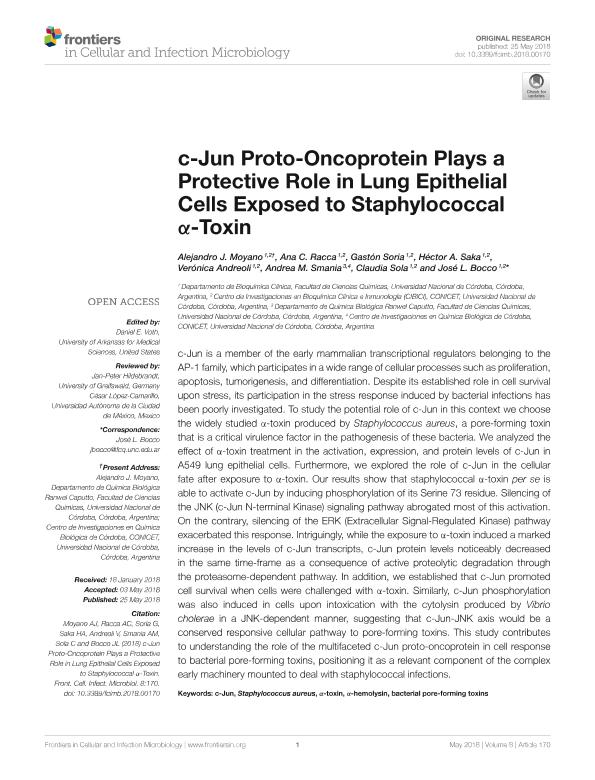Mostrar el registro sencillo del ítem
dc.contributor.author
Moyano, Alejandro Jose

dc.contributor.author
Racca, Ana Cristina

dc.contributor.author
Soria, Ramiro Gaston

dc.contributor.author
Saka, Hector Alex

dc.contributor.author
Andreoli, Veronica

dc.contributor.author
Smania, Andrea

dc.contributor.author
Sola, Claudia del Valle

dc.contributor.author
Bocco, Jose Luis

dc.date.available
2020-01-24T22:45:43Z
dc.date.issued
2018-05
dc.identifier.citation
Moyano, Alejandro Jose; Racca, Ana Cristina; Soria, Ramiro Gaston; Saka, Hector Alex; Andreoli, Veronica; et al.; c-Jun Proto-Oncoprotein Plays a Protective Role in Lung Epithelial Cells Exposed to Staphylococcal α-toxin; Frontiers Media SA; Frontiers in Cellular and Infection Microbiology; 8; 5-2018; 1-9
dc.identifier.issn
2235-2988
dc.identifier.uri
http://hdl.handle.net/11336/95816
dc.description.abstract
c-Jun is a member of the early mammalian transcriptional regulators belonging to the AP-1 family, which participates in a wide range of cellular processes such as proliferation, apoptosis, tumorigenesis, and differentiation. Despite its established role in cell survival upon stress, its participation in the stress response induced by bacterial infections has been poorly investigated. To study the potential role of c-Jun in this context we choose the widely studied α-toxin produced by Staphylococcus aureus, a pore-forming toxin that is a critical virulence factor in the pathogenesis of these bacteria. We analyzed the effect of α-toxin treatment in the activation, expression, and protein levels of c-Jun in A549 lung epithelial cells. Furthermore, we explored the role of c-Jun in the cellular fate after exposure to α-toxin. Our results show that staphylococcal α-toxin per se is able to activate c-Jun by inducing phosphorylation of its Serine 73 residue. Silencing of the JNK (c-Jun N-terminal Kinase) signaling pathway abrogated most of this activation. On the contrary, silencing of the ERK (Extracellular Signal-Regulated Kinase) pathway exacerbated this response. Intriguingly, while the exposure to α-toxin induced a marked increase in the levels of c-Jun transcripts, c-Jun protein levels noticeably decreased in the same time-frame as a consequence of active proteolytic degradation through the proteasome-dependent pathway. In addition, we established that c-Jun promoted cell survival when cells were challenged with α-toxin. Similarly, c-Jun phosphorylation was also induced in cells upon intoxication with the cytolysin produced by Vibrio cholerae in a JNK-dependent manner, suggesting that c-Jun-JNK axis would be a conserved responsive cellular pathway to pore-forming toxins. This study contributes to understanding the role of the multifaceted c-Jun proto-oncoprotein in cell response to bacterial pore-forming toxins, positioning it as a relevant component of the complex early machinery mounted to deal with staphylococcal infections.
dc.format
application/pdf
dc.language.iso
eng
dc.publisher
Frontiers Media SA

dc.rights
info:eu-repo/semantics/openAccess
dc.rights.uri
https://creativecommons.org/licenses/by/2.5/ar/
dc.subject
A-HEMOLYSIN
dc.subject
A-TOXIN
dc.subject
BACTERIAL PORE-FORMING TOXINS
dc.subject
C-JUN
dc.subject
STAPHYLOCOCCUS AUREUS
dc.subject.classification
Epidemiología

dc.subject.classification
Ciencias de la Salud

dc.subject.classification
CIENCIAS MÉDICAS Y DE LA SALUD

dc.title
c-Jun Proto-Oncoprotein Plays a Protective Role in Lung Epithelial Cells Exposed to Staphylococcal α-toxin
dc.type
info:eu-repo/semantics/article
dc.type
info:ar-repo/semantics/artículo
dc.type
info:eu-repo/semantics/publishedVersion
dc.date.updated
2019-10-22T16:30:26Z
dc.journal.volume
8
dc.journal.pagination
1-9
dc.journal.pais
Estados Unidos

dc.journal.ciudad
Louisville
dc.description.fil
Fil: Moyano, Alejandro Jose. Consejo Nacional de Investigaciones Científicas y Técnicas. Centro Científico Tecnológico Córdoba. Centro de Investigaciones en Bioquímica Clínica e Inmunología; Argentina. Universidad Nacional de Córdoba. Facultad de Ciencias Químicas. Departamento de Bioquímica Clínica; Argentina
dc.description.fil
Fil: Racca, Ana Cristina. Universidad Nacional de Córdoba. Facultad de Ciencias Químicas. Departamento de Bioquímica Clínica; Argentina. Consejo Nacional de Investigaciones Científicas y Técnicas. Centro Científico Tecnológico Córdoba. Centro de Investigaciones en Bioquímica Clínica e Inmunología; Argentina
dc.description.fil
Fil: Soria, Ramiro Gaston. Consejo Nacional de Investigaciones Científicas y Técnicas. Centro Científico Tecnológico Córdoba. Centro de Investigaciones en Bioquímica Clínica e Inmunología; Argentina. Universidad Nacional de Córdoba. Facultad de Ciencias Químicas. Departamento de Bioquímica Clínica; Argentina
dc.description.fil
Fil: Saka, Hector Alex. Universidad Nacional de Córdoba. Facultad de Ciencias Químicas. Departamento de Bioquímica Clínica; Argentina. Consejo Nacional de Investigaciones Científicas y Técnicas. Centro Científico Tecnológico Córdoba. Centro de Investigaciones en Bioquímica Clínica e Inmunología; Argentina
dc.description.fil
Fil: Andreoli, Veronica. Universidad Nacional de Córdoba. Facultad de Ciencias Químicas. Departamento de Bioquímica Clínica; Argentina. Consejo Nacional de Investigaciones Científicas y Técnicas. Centro Científico Tecnológico Córdoba. Centro de Investigaciones en Bioquímica Clínica e Inmunología; Argentina
dc.description.fil
Fil: Smania, Andrea. Consejo Nacional de Investigaciones Científicas y Técnicas. Centro Científico Tecnológico Conicet - Córdoba. Centro de Investigaciones en Química Biológica de Córdoba. Universidad Nacional de Córdoba. Facultad de Ciencias Químicas. Centro de Investigaciones en Química Biológica de Córdoba; Argentina
dc.description.fil
Fil: Sola, Claudia del Valle. Consejo Nacional de Investigaciones Científicas y Técnicas. Centro Científico Tecnológico Córdoba. Centro de Investigaciones en Bioquímica Clínica e Inmunología; Argentina. Universidad Nacional de Córdoba. Facultad de Ciencias Químicas. Departamento de Bioquímica Clínica; Argentina
dc.description.fil
Fil: Bocco, Jose Luis. Consejo Nacional de Investigaciones Científicas y Técnicas. Centro Científico Tecnológico Córdoba. Centro de Investigaciones en Bioquímica Clínica e Inmunología; Argentina. Universidad Nacional de Córdoba. Facultad de Ciencias Químicas. Departamento de Bioquímica Clínica; Argentina
dc.journal.title
Frontiers in Cellular and Infection Microbiology
dc.relation.alternativeid
info:eu-repo/semantics/altIdentifier/url/https://www.frontiersin.org/article/10.3389/fcimb.2018.00170/full
dc.relation.alternativeid
info:eu-repo/semantics/altIdentifier/doi/http://dx.doi.org/10.3389/fcimb.2018.00170
Archivos asociados
